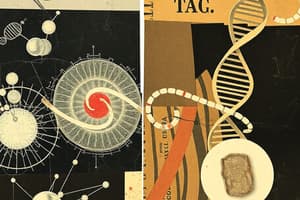Podcast
Questions and Answers
What primarily composes chromatin?
What primarily composes chromatin?
- Coiled strands of DNA and basic proteins (histones) (correct)
- Circular DNA and transcription factors
- Coiled strands of RNA and ribosomal proteins
- Single-stranded DNA and nucleotides
What identifies the function of the nucleolus within the cell nucleus?
What identifies the function of the nucleolus within the cell nucleus?
- Coordination of heterochromatin assembly
- Active transcription of messenger RNA
- Storage of rRNA and formation of ribosomal subunits (correct)
- Synthesis of ribosome proteins from DNA
Which statement best describes heterochromatin?
Which statement best describes heterochromatin?
- It represents the active form of chromatin.
- It is the only form of chromatin found in actively dividing cells.
- It is less coiled and appears as lightly stained areas.
- It is electron dense and represents the inactive form of chromatin. (correct)
What is the structure that serves as the basic unit of chromatin?
What is the structure that serves as the basic unit of chromatin?
What is the visible form of sex chromatin observed in female mammalian cells?
What is the visible form of sex chromatin observed in female mammalian cells?
How is the functional state of the nucleus often interpreted?
How is the functional state of the nucleus often interpreted?
How does male chromosomal structure differ from female chromosomal structure?
How does male chromosomal structure differ from female chromosomal structure?
What role do histones primarily play in the structure of chromatin?
What role do histones primarily play in the structure of chromatin?
What does the nucleoplasm contain?
What does the nucleoplasm contain?
What appearance does sex chromatin take in neutrophilic leukocytes when observed in blood smears?
What appearance does sex chromatin take in neutrophilic leukocytes when observed in blood smears?
Flashcards
Chromatin structure
Chromatin structure
Coiled DNA strands bound to histone proteins, forming nucleosomes.
Nucleosome
Nucleosome
The basic structural unit of chromatin, consisting of DNA wrapped around histone proteins.
Heterochromatin
Heterochromatin
Inactive form of chromatin; electron-dense and darkly stained.
Euchromatin
Euchromatin
Signup and view all the flashcards
Chromatin activity
Chromatin activity
Signup and view all the flashcards
Nucleolus
Nucleolus
Signup and view all the flashcards
Ribosomal subunits
Ribosomal subunits
Signup and view all the flashcards
Nucleoplasm
Nucleoplasm
Signup and view all the flashcards
Study Notes
Nucleus and Phases of Cell Cycle
- The nucleus contains DNA blueprint for all cell structures, and the molecular machinery to replicate DNA and synthesize three types of RNA (rRNA, mRNA, tRNA).
- The nucleus does not produce proteins; it imports needed proteins from the cytoplasm.
- The nucleus is usually a rounded or elongated structure in the center of the cell, visible with light microscopy (LM) as a dark blue or black structure.
- The nucleus is surrounded by a nuclear envelope composed of two parallel membranes, the perinuclear cisterna, and nuclear pores.
- These nuclear pores allow for controlled exchange of substances between the nucleus and the cytoplasm.
- Chromatin is mainly coiled DNA and basic proteins (histones), arranged as nucleosomes.
- Two types of chromatin exist: heterochromatin (electron dense, inactive) and euchromatin (less coiled, active).
- The nucleolus, a spherical structure rich in rRNA and protein, is typically basophilic; it synthesizes ribosome subunits that migrate to the cytoplasm through nuclear pores.
Cell Cycle
- The cell cycle is a series of events preparing cells for division into two daughter cells.
- Interphase is the longest period of the cell cycle, where the cell grows, and replicates its genetic material.
- Interphase has three stages:
- G1 (gap 1) phase: Cell growth, synthesis of macromolecules essential for DNA duplication begins.
- S (synthesis) phase: DNA is duplicated.
- G2 (gap 2) phase: Cell prepares for mitosis, including centriole duplication, and energy storage.
- Mitosis is the shorter phase where the nucleus and cytoplasm divide, creating two daughter cells.
- G0 phase (outside cycle): A resting phase, cells may exit the cell cycle either permanently or temporarily.
Studying That Suits You
Use AI to generate personalized quizzes and flashcards to suit your learning preferences.




